 Back to the Be Inspired Blog
Back to the Be Inspired Blog

Create a Terrarium Inspired by Nature
Terrariums bring a touch of nature indoors, creating tiny, self-sustaining ecosystems that add beauty and tranquility to your home. Whether you're inspired by lush rainforests, serene beaches, or rugged desert landscapes, crafting a DIY terrarium allows you to capture the essence of your favorite places in a stunning, low-maintenance display.
Follow these simple steps to design a terrarium that reflects your style and thrives with minimal care.
Step 1: Find Your Inspiration in Nature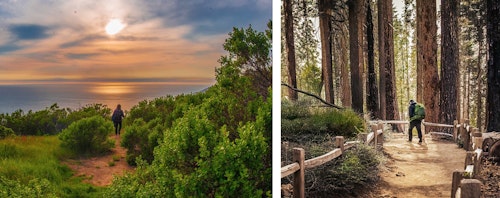
The best terrariums tell a story, drawing inspiration from nature’s most breathtaking scenes. Take a walk in your favorite local park, a hiking trail, or even a weekend trip to a beloved destination like Big Sur, Yosemite, or Muir Woods. Observe the plants, textures, and colors that captivate you.
Pro Tip: Snap some reference photos or collect small, natural keepsakes (where permitted), like pebbles, driftwood, or sand, to personalize your terrarium and make it a true reflection of your experience.

Step 2: Choose the Right Terrarium Vessel
The type of container you choose will influence both the aesthetics and functionality of your terrarium. Consider the following:
- Hanging Glass Orbs or Geometric Shapes work well for trailing plants and can be suspended near windows for a floating greenery effect.
- Open Terrariums allow for better airflow, making them ideal for succulents, cacti, and air plants.
- Geometric or Shaped Containers (like cubes, pyramids, or bubble-shaped vessels) can enhance different design themes, from minimalist to whimsical.
- Closed Terrariums (with lids) retain moisture and create a humid environment, perfect for ferns, mosses, and tropical plants.
Step 3: Select the Right Plants
Once you’ve chosen your container, it’s time to pick plants that will thrive in the environment you're creating. Consider these options:
For Humid, Tropical Terrariums: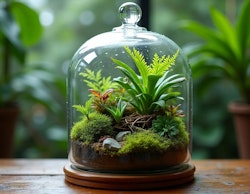
- Ferns
- Mosses
- Fittonia (Nerve Plant)
- Baby’s Tears
For Dry, Open Terrariums: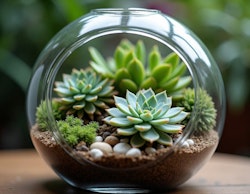
- Succulents (Echeveria, Haworthia, Jade Plant)
- Cacti
- Air Plants (Tillandsia)
For Beachy or Coastal Themes: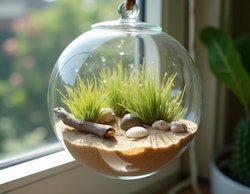
- Miniature grasses
- Air plants
- Driftwood or shell accents
Pro Tip: Stick with plants that have similar light, water, and humidity needs to ensure long-term success. Not sure what to choose? Our experts at SummerWinds Nursery can help!
Step 4: Assemble Your Terrarium Like a Pro
Layering for Success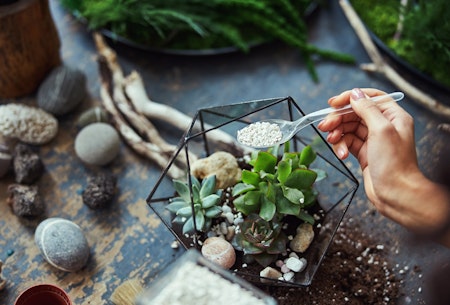
A well-built terrarium starts with proper layering to maintain drainage and plant health. Follow this order:
1. Drainage Layer – Begin with a layer of small stones or pebbles to prevent excess water from pooling.
2. Activated Charcoal – This optional layer helps control moisture and prevent odors in closed terrariums.
3. Soil Mix – Use the appropriate soil for your plant selection. Cactus soil for succulents, moisture-retaining soil for tropical plants.
4. Plants & Decorative Elements – Arrange your plants first, then add moss, driftwood, stones, or small figurines to complete your miniature landscape.
Get Creative! Add personal touches with decorative sand, colorful pebbles, or tiny accessories to bring your theme to life.
Step 5: Terrarium Care & Maintenance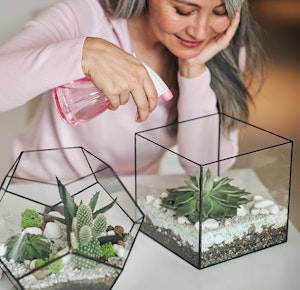
Once your terrarium is complete, it’s time to keep it thriving!
- Light: Place your terrarium in bright, indirect light. Avoid direct sun for closed terrariums, as heat can build up quickly.
- Watering: Mist tropical terrariums occasionally; water succulents sparingly to prevent root rot.
- Pruning & Cleaning: Trim overgrown plants, remove dead leaves, and wipe the glass as needed.
Show Off Your Creation!
We’d love to see your finished terrariums! Share your masterpiece on Instagram and tag us @summerwindsca for a chance to be featured.

